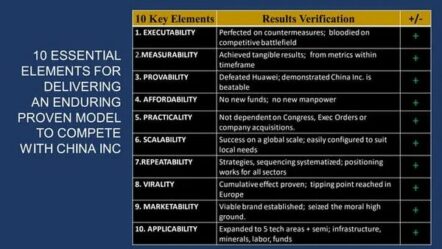Stanford Business School Case Study on Chips & Science Act: Keith Krach
History of the $280B Bipartisan Chips and Science Act
The Chips and Science Act in essence merged the Endless Frontiers Act and the Chips for America Act. Those two pieces combined with what we put in the Bill for Economic Statecraft probably makeup 95% of the bill. This legislation was a vital element of our mission to develop and operationalize a Global Economic Security Strategy that would drive economic growth, maximize national security and combat China’s techno-economic aggression.
• The Global Economic Security Strategy (GESS) integrated three distinct pillars of action consisting of turbocharging economic competitiveness and innovation, safeguarding America’s assets and building a network of trusted partners.
• The first pillar focused on investing in R&D, retraining the workforce, increasing access to capital, fostering STEM education, and rebuilding the manufacturing base, all of which were incorporated in his team’s early design of the $280B bipartisan Chips and Science Act.
• The second pillar concentrated on protecting technology from our strategic adversaries, securing supply chains, strengthening IP protections, and preserving the gold stand of our capital markets. The $12B onshoring of TSMC was a direct result of the plan.
• The third pillar created the Trust Doctrine to build the Clean Network Alliance and companies for driving the adoption of trusted technology. The 5G Trifecta which included TSMC was the opening salvo in defeating China’s 5G masterplan. The Endless Frontier Act was initially conceived in November 2019 and presented to Senators Schumer and Young to authorize about $150 billion for boosting investment in high-tech research vital to our national security in 10 tech-intensive industries. The bipartisan legislation which was introduced a few months later.
• The strategic plan we presented to senators and congressmen demonstrated how to grow this critical high-tech research investment to $500 billion with matches from the private sector and our closest technological allies. We later validated this and garnered significant interest from companies and countries that became members of the Clean Network.
The CHIPS Act portion of the Chips and Science Act was derived from our combined State and Commerce Department team’s historic $12 billion onshoring of Taiwan Semiconductor Manufacturing Company (TSMC), which appropriated nearly $53 billion to bring back American semiconductor manufacturing.
o Our strategy was for the TSMC announcement to serve as a stimulus that would lead to the fortification of a trusted supply chain by attracting TSMC’s broad ecosystem of suppliers, persuading other chip companies to produce in U.S. and inspiring universities to develop chip engineering.
TSMC was the crucial catalyst to design a bipartisan bill providing the necessary funding. That is why we reached out to Senator Cornyn and Warner.





